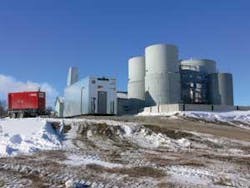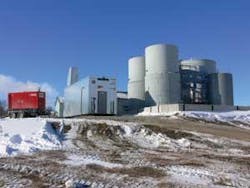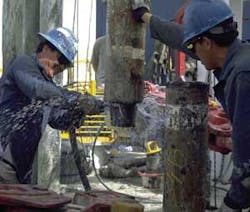Managing drilling fluids economically and optimizing their effectiveness while still keeping those operations environmentally benign can be among the trickiest balancing acts operators and drilling contractors face today.
Those drilling fluids challenges are getting tougher as industry plunges into ever-deeper waters and penetrates ever-deeper formations.
Specialized applications
As the drilling industry matures and the search for hydrocarbons moves into even more challenging environments, the need for innovative and novel drilling solutions has taken on greater importance, according to Baker Hughes Drilling Fluids: “The utilization of specialized drilling fluid additives is becoming more prevalent, especially in depleted fields and in deep and ultradeep waters. These challenging wells require more than just traditional additives to successfully achieve the goal of moving oil and gas from the reservoir into the refining process.”
In response to that need, Baker Hughes has been developing synthetic-based compliant emulsion systems for drilling in challenging downhole conditions, such as deepwater and high-pressure/high-temperature (HPHT) wells, while meeting stringent environmental requirements.
“These developments were driven by the extreme HPHT environment associated with deep shelf drilling in the Gulf of Mexico and the deviated HPHT wells drilled in the North Sea,” the company says. “Laboratory testing demonstrates fluid stability at temperatures in excess of 580 °F and pressures exceeding 30,000 psi.
“Since 2001 Baker Hughes Drilling Fluids has been working on perfecting a major change in HPHT emulsion-based systems. Although the revision was initially triggered by environmental legislation changes in the North Sea area, the developments and improved chemistries have demonstrated superior performance in both diesel-based fluids and in the synthetic fluids used in the Gulf of Mexico and other areas of the world. The chemistries chosen deliver minimal impact on the environment and to the health and safety of the personnel involved in the drilling operation.”
Baker Hughes Drilling Fluids’ high-performance water-based muds (HPWBM) are designed to emulate the performance attributes of invert-emulsion systems. The need for environmentally safe and technically equivalent, water-based alternatives to emulsion systems is increasingly becoming an important consideration in the drilling fluid selection process. Baker Hughes Drilling Fluids was the first service company to introduce HPWBM, starting with the AQUA-DRILL System, based on cloud-point glycols, in the early 1990s.
“We have continually researched technology to constantly improve high performance water-based muds. New technology such as MAX-SHIELD™ and MAX-PLEX™, which improves shale stability by reducing pore pressure transmission, and MAX-GUARD, which suppresses the hydration and dispersion of gumbo and reactive clays, have proven to be significant performance-enhancement products in our HPWBM product line,” the company says.
Deeper drilling
The key word for drilling fluids challenges today is “deeper,” says Robin J. Verret, director of research and development for Turbo-Chem International Inc.
“From deeper water to deeper wells, the challenges are daunting,” he says. “In the deepwater arena, not only do we have to ensure environmental compatibility with the regulatory agencies, but compatibility also with the harsh and drastic downhole environments that must be drilled, to reach the particular oil or gas commodity the operator is searching for.
“The various drilling fluids must be able to withstand vast temperature fluctuations from near freezing at the seafloor to >450 °F downhole in some cases. This must also be accomplished under the massive pressure changes from atmosphere at the surface to >20,000 psi, depending on the fluid weight, which is where the HPHT systems come into play. Our products must also be compatible with these environments and have no negative impact on the fluid make-up that would change the fluid flow properties or chemistry.”
“The deeper the operators drill, whether in the water or on land, the dynamics will continue to push the envelope of temperature and pressure capabilities of the drilling fluid.” — Robin Verret, Turbo-Chem
The deeper the operators drill, whether in the water or on land, the dynamics will continue to push the envelope of temperature and pressure capabilities of the drilling fluid, contends Verret.
“The continued development of environmentally acceptable water-based drilling fluids that match or correlate closely to the high-performance characteristics of invert emulsion fluids is having a very significant impact on the industry.” — Don McKenzie, M-I Swaco
“Actually, any specialty additives must not only be able to withstand these harsh, extreme drilling environmental changes, but these additives should actually contribute to the stability and success of the system as well. That is our task in the research and development department here.”
Environmental concerns
The environmental compatibility of drilling, completion, and workover fluids and the additives used in them is an imperative for drilling fluids vendors.
“Much of what we do here at Turbo-Chem is in conjunction with the drilling fluids vendor’s system in use in the well at the time,” Verret notes. “It is imperative that our additives are environmentally compatible with that system, or in many cases, systems, to prevent any potential regulatory infractions.”
Noting the many drilling fluids systems in use worldwide and the large array of regulatory and environmental requirements, Verret adds, “We spend a great amount of time and resources testing our products in the different systems to ensure compatibility.”
Don McKenzie, president and CEO of M-I Swaco, contends that the continued development of environmentally acceptable water-based drilling fluids that match or correlate closely to the high-performance characteristics of invert emulsion fluids is having a “very significant impact” on the industry.
Operators benefit from the value-added performance that oil-based muds deliver, while “also removing the environmental obstacles and associated costs that limit the use of oil-based fluids in many operating theaters,” he adds.
New technologies
Wellbore stability and preventing or remediating lost circulation will be paramount for the operator’s ability to drill with the various drilling fluids systems, according to Verret.
“Each one of the various systems has its own idiosyncrasies regarding compatibility and success of accomplishment, when utilizing specialty additives such as ours,” he points out. “Each system has its arena of use, which are as varied as the number of systems. The key for our success is to have products that are ‘cross-compatible.’ By that I mean products that function as well in most of the water-based, oil-based, and synthetic-based systems. The same product might function as an HPHT additive in one system and as a seepage loss prevention additive in another. Or one particular product might be ‘system’ compatible with all of these systems. Of course, this is the optimum, but not always achievable. Without some cross-compatibility, the vast array of products that would be necessary to maintain would create quite a warehousing, logistics, and accounting dilemma.”
Another growing problem is fluid movement, notes Verret. “The deeper the operators drill and the more extended the reach of directional wells, the more pressure is required to ‘move’ the drilling fluid efficiently,” he says. “This added pressure increases the overall bottomhole pressure, known as equivalent circulating density (ECD). This increase in ECD increases the risk of formation fracturing, leading to lost circulation and possible loss of the wellbore.
“Many of the drilling fluids companies are developing shear-thinning drilling fluids by reducing the strength of the gel structure, to overcome this challenge. However, recent research indicates that lost circulation is influenced by the strength of the gel structure of the fluid. The lower the gel structure strength or the more shear-thinning the fluid, the more prone that fluid is to lost circulation. The solution to one problem actually increases the possibility of another problem. This is another area that we are working in: Testing the compatibility of our current products and working to develop new products that can be used in these shear-thinning fluids without affecting the weaker gel structures, yet preventing the losses from occurring.”
One of the major challenges for the industry is developing specialty products for HPHT drilling, says Verret: “As the operators search deeper and more hostile environments, specialized fluid systems and additives will be required to accomplish this task. We are not only working on developing products to aid in reducing the fluid loss properties of these systems, but we are also looking at ways to make our seepage and lost circulation additives capable of withstanding these environments. Thus far, we have relied on organic materials for many of our additives, but these organic materials can have a weakness: thermal degradation. Our goal has been, and continues to be, finding ways to extend the temperature and pressure range of our existing products and developing new products capable of performing as well as our existing products, in these harsh complex environments, at which I’m happy to say, we’ve been pretty successful.”
Drill-in fluids comprise another area that Turbo-Chem has been investigating.
“These drill-in-fluids, such as Formates, for example, are basically solids-free systems,” Verret notes. “While these solids-free systems are very formation friendly, this solids-free state creates a dilemma for the operator. What to do when lost circulation occurs with fluids that cost $900/bbl or greater? We are looking at a number of materials and chemistries that will be able to prevent or control losses without compromising the formation friendliness of these types of fluids.”
As the wells have become more complicated, the drilling fluids have followed suit, Verret contends.
“Things are no longer simple, and it’s taken some cutting-edge science to get drilling technology to where it is today,” he says. “We’ve had to follow this lead here at Turbo-Chem as well. No longer is it simply putting bagasse or sawdust in the drilling fluid to stop lost circulation. We’ve had to apply quite a bit of science in our field.
“With all of the new technology has come new opportunities to learn what we are actually dealing with downhole. With MWD, LWD, PWD, and all the other ‘WDs,’ we now have a better idea of what we are up against when it comes to wellbore stability and lost circulation issues. We’ve even got actual downhole photographs and videos available, which actually allow us to see the types and size of the fracturing occurring in vertical, directional, and horizontal wells, through various formation types…I believe we’re just in the infancy stages of many of these emerging technologies. Just 10 years ago MWD was considered voodoo by many, but today almost no one drills a well without it.”
Efficiencies
The most expensive and most difficult to control commodity in the entire drilling arena is time, contends Verret.
“Time isn’t getting any cheaper either. There are many time bandits in the drilling of a well, and several that are directly related to the hole, such as rate of penetration, seepage loss or lost circulation, tripping in or out of the hole, etc. As the operators drill deeper, the time cost of these activities rises almost exponentially. That’s the real value of the products and services we market. If we can save the operator downtime or help expedite a process, then we’ve put money back into the operator’s drilling budget, which then can be used to drill additional wells. The research and product development that we do is juxtaposed with time. Not only do we need to determine how does what we are adding to the drilling fluid affect the mud and wellbore, but is this effect going to save time? If we can capture all of these in a single product, then we’ve hit an R&D home run.”





